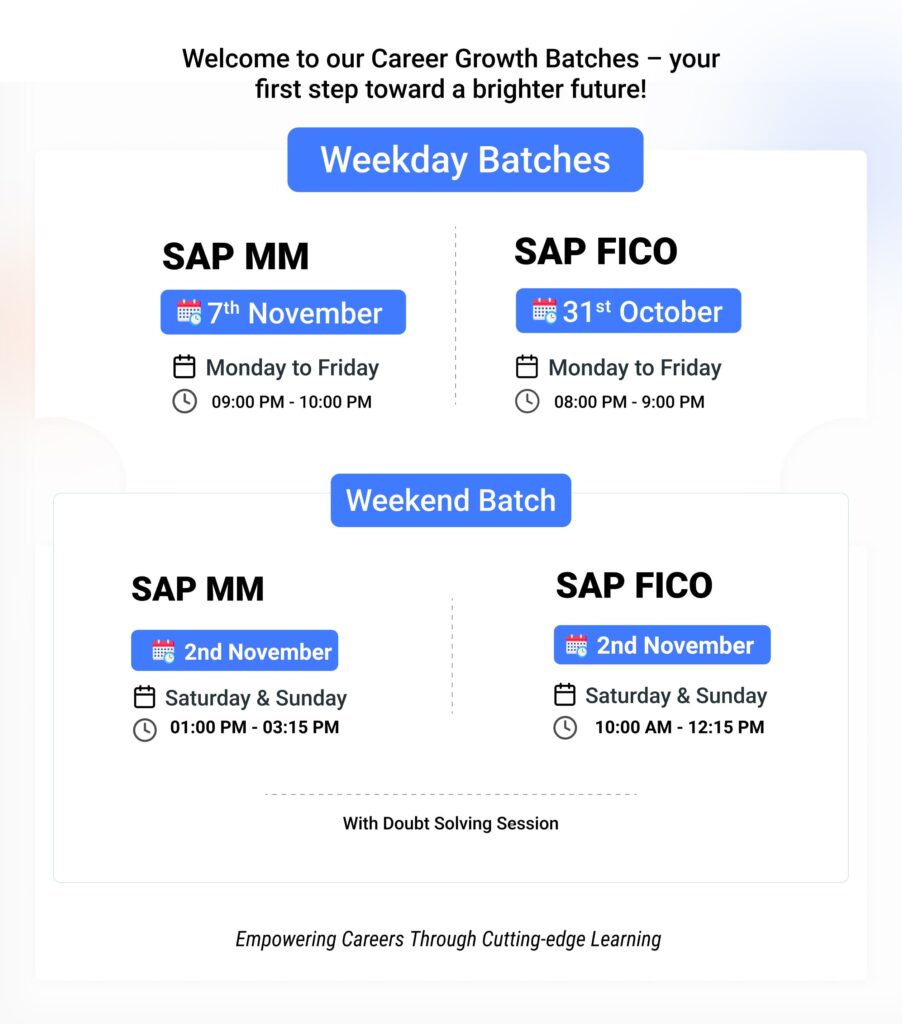Organizational Structure in SAP MM – A Complete Beginner’s Guide (2025)
In the world of SAP MM (Materials Management), understanding the organizational structure is one of the first and most important steps. This structure defines how a company’s purchasing, inventory, and materials management processes are arranged in the SAP system.
If you are new to SAP or planning to start your SAP MM journey, this topic forms the backbone of your learning. In this blog, we’ll explain — in simple terms — what the organizational structure in SAP MM is, why it’s important, how it’s configured, and how it works in real business scenarios.
Let’s get started!
Connect With Us: WhatsApp

What Is Organizational Structure in SAP MM?
The organizational structure in SAP MM represents the hierarchical arrangement of business units that defines how materials and purchasing processes are managed.
It connects all parts of the business — from company codes to plants, storage locations, and purchasing organizations — ensuring smooth coordination between departments.
In short, it shows how your company is set up inside SAP.
Example:
If you work at GTR Academy, which provides SAP training across multiple cities, you could have:
-
One head office (company code)
-
Multiple training centers (plants)
-
Storage rooms for equipment (storage locations)
-
Separate purchasing teams (purchasing organizations)
This structure allows GTR Academy to manage its materials, supplies, and purchasing activities efficiently across all locations.
Why Is Organizational Structure Important in SAP MM?
The organizational structure is the foundation for all MM-related transactions in SAP. Without it, you can’t perform key tasks like creating purchase orders, managing inventory, or posting goods receipts.
Here’s why it matters:
-
Defines Responsibilities: It clarifies who manages which materials or plants.
-
Streamlines Processes: Ensures smooth flow between purchasing, inventory, and finance.
-
Supports Integration: Connects MM with other SAP modules like FI (Finance), SD (Sales), and PP (Production Planning).
-
Improves Transparency: Every movement of material is linked to a specific organizational unit.
-
Enables Accurate Reporting: Helps generate detailed reports by plant, storage location, or purchasing organization.
Main Elements of Organizational Structure in SAP MM
The SAP MM organizational structure consists of several key components that work together. Let’s understand each step by step.
1. Client
The Client is the topmost level in the SAP system hierarchy. It represents the entire group or enterprise.
All company codes, plants, and other entities exist under a single client.
Example: GTR Academy as a whole can be one client in SAP.
2. Company Code
The Company Code represents a legal entity within the organization. It is used for financial accounting and reporting.
Each company code maintains its own balance sheets and profit & loss statements.
Example:
-
GTR100 – GTR Academy India
-
GTR200 – GTR Academy UK
3. Plant
A Plant is an important element in SAP MM. It represents a location where materials are produced, stored, or distributed.
In SAP, a plant could be a manufacturing unit, warehouse, training center, or service location.
Example:
-
Plant 1010 – GTR Academy Delhi Center
-
Plant 1020 – GTR Academy Mumbai Center
4. Storage Location
A Storage Location is where materials are physically kept within a plant.
It allows organizations to track inventory at a more detailed level.
Example:
-
SL01 – Classroom Equipment Storage
-
SL02 – Office Supplies Storage
5. Purchasing Organization
The Purchasing Organization handles all procurement and purchasing activities for the company.
It is responsible for negotiating with vendors, managing purchase orders, and maintaining supplier data.
Types of Purchasing Organizations:
-
Centralized: Handles purchasing for all plants.
-
Plant-Specific: Handles purchasing for individual plants.
Example: GTR Academy may have a Central Purchasing Organization for all training centers across India.
6. Purchasing Group
A Purchasing Group represents the person or team responsible for daily purchasing operations, like requesting quotations or creating purchase orders.
It answers the question: “Who is doing the purchasing?”
Example:
-
PG01 – IT Equipment Purchases
-
PG02 – Classroom Materials Purchases
How to Configure Organizational Structure in SAP MM
To configure the organizational structure in SAP, follow these simple steps:
-
Go to SPRO (SAP Reference IMG)
-
Navigate to:
Enterprise Structure → Definition → Materials Management -
Define:
-
Company Code
-
Plant
-
Storage Location
-
Purchasing Organization
-
Purchasing Group
-
-
After defining, go to Assignment, and link the elements:
-
Assign Plant to Company Code
-
Assign Purchasing Organization to Company Code and Plant
-
Assign Purchasing Group to Purchasing Organization
-
Once configured, these units become the backbone of all SAP MM activities such as procurement, inventory management, and invoice verification.
Organizational Structure in SAP MM Example
Let’s take a simple example to make it clear:
Suppose GTR Academy has its head office in Bangalore and training centers in Mumbai and Delhi.
-
The Client is GTR Global.
-
The Company Code is GTR100 (India).
-
The Plants are:
-
1010 – GTR Mumbai
-
1020 – GTR Delhi
-
-
The Storage Locations include:
-
SL01 – Projector and Classroom Equipment
-
SL02 – Office Stationery
-
-
The Purchasing Organization is GTR_PUR (handles all training centers).
-
The Purchasing Groups are divided as:
-
001 – IT and Software Purchases
-
002 – Educational Materials
-
This structure helps GTR Academy manage every purchase and stock movement efficiently and transparently.
SAP MM Organizational Structure Configuration PDF and PPT
If you want to review or present this setup, you can refer to:
-
SAP MM Organizational Structure PDF for documentation.
-
SAP MM Enterprise Structure PPT for training or classroom presentations.
GTR Academy provides both during its SAP MM training program, helping students learn configuration step-by-step with practical examples.
Common SAP MM Organizational Structure Tables
SAP stores organizational data in several backend tables. Some important ones include:
-
T001: Company Codes
-
T001W: Plants
-
T001L: Storage Locations
-
T024: Purchasing Groups
-
T024E: Purchasing Organizations
These tables are used during configuration and for reporting purposes.
Learn SAP MM Organizational Structure with GTR Academy
If you’re serious about building a career in SAP MM, understanding the organizational structure is your first step toward success.
GTR Academy is one of the top SAP training institutes that offers:
-
SAP MM online and classroom training with real-time system access.
-
Step-by-step configuration practice for organizational structure.
-
SAP MM study materials, PDFs, and PPTs for easy understanding.
-
Industry-oriented projects and placement support.
-
Affordable SAP course fees with flexible learning options.
Whether you’re a fresher or a professional looking to upgrade your career, GTR Academy helps you master SAP MM with hands-on guidance.
Top 10 FAQs About Organizational Structure in SAP MM
1. What is the organizational structure in SAP MM?
The organizational structure in SAP MM is the framework that defines how a company’s materials management and procurement activities are organized. It includes key elements such as client, company code, plant, storage location, purchasing organization, and purchasing group.
2. Why is the organizational structure important in SAP MM?
It’s important because it helps define the flow of information, responsibilities, and reporting. Without it, you can’t perform key MM functions like purchasing, inventory tracking, or goods receipt in SAP.
3. What are the main components of the organizational structure in SAP MM?
-
Client
-
Company Code
-
Plant
-
Storage Location
-
Purchasing Organization
-
Purchasing Group
4. What is a client in SAP MM?
A Client is the highest level in the SAP system hierarchy. It represents the entire enterprise, containing all company codes and plants under it.
5. What is the difference between a Company Code and a Plant?
A Company Code represents a legal entity that maintains financial records, while a Plant is a physical location such as a warehouse, factory, or training center where materials are stored or managed.
6. What is a Purchasing Organization in SAP MM?
A Purchasing Organization is responsible for procurement and vendor negotiations. It defines where and how the purchasing process is managed.
7. What is the role of a Purchasing Group in SAP MM?
A Purchasing Group represents the individual or team responsible for executing purchasing activities, like creating purchase orders and dealing with suppliers.
8. What is the relationship between a Plant and Storage Location?
A Plant can have one or more Storage Locations, which represent specific areas where materials are stored within that plant.
9. How can I configure the organizational structure in SAP MM?
Navigate to:
SPRO → Enterprise Structure → Definition → Materials Management
Here, define and assign all key elements like Company Code, Plant, Storage Location, Purchasing Organization, and Purchasing Group.
10. How can I learn SAP MM organizational structure configuration step by step?
You can learn it through SAP MM online or classroom training.
Institutes like GTR Academy offer:
-
Detailed sessions on organizational structure setup.
-
Hands-on practice using live SAP servers.
-
Study materials, PDFs, and PPTs for better understanding.
-
Job-oriented training with expert guidance.
Connect With Us: WhatsApp
Conclusion
The Organizational Structure in SAP MM is the heart of the Materials Management module. It defines how your company operates within SAP — from purchasing materials to managing inventory and suppliers.
By properly setting up company codes, plants, and purchasing units, businesses can ensure smooth integration between procurement, logistics, and finance.
And if you want to learn how to configure this structure practically, GTR Academy offers complete SAP MM training designed to make you industry ready.
Start learning today and take your first step toward becoming a certified SAP MM professional!








